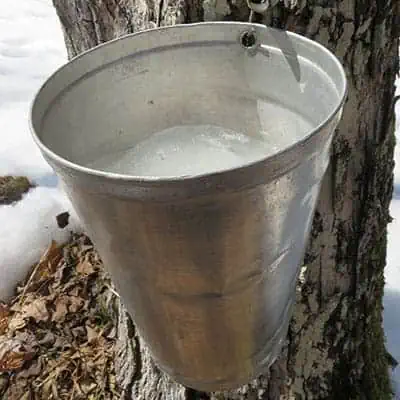Those of us who normally rely on stock tanks, water troughs, and water buckets face a challenge when the temperature drops below freezing. To keep your animals’ water source from freezing over, you may want to consider a stock tank de-icer.
When used correctly, these devices can keep tanks, troughs, and other vessels ice free and ensure that your animals can drink whenever they need to.
Best Stock Tank Heaters
1) K&H Pet Products Stock Tank Deicer
- THERMOSTATICALLY CONTROLLED: This deicer automatically turns on and off as needed to keep your stock tank from freezing over; available in 5...
- FLOATING OR SUBMERSIBLE: This stock tank deicer can be used as a floating deicer or a submersible deicer and includes a full cage and cord...
- SAFE FOR ALL STOCK TANKS: The K&H Ultimate Deicers are safe for all stock tanks, no need to buy extra cages or parts, and they include a 2...
K&H’s de-icer is one of the most versatile on the market. Available in 5 different wattages ranging from 250 W to 1500 W, this device is especially notable because it can be used as either a floating or submersible de-icer. Switching between the two options is easy — just remove or reattach the Styrofoam-lined ring as needed. K&H’s product is also safe for both plastic and metal tanks, making it truly one of the most flexible de-icers on the market. (K&H’s website does not list what material the heating unit is made from.)
This de-icer comes with a few convenience features, too. The device has an internal thermostat that automatically turns the unit on and off to keep tank water just above freezing temperature (note that there is no on/off switch — the device is “on” whenever it’s plugged in, even when it isn’t heating). Additionally, each K&H de-icer comes with a plastic “cord clip” designed to keep the cord out of animals’ reach. Each model weighs 3 pounds or less, and all are MET listed for safety. K&H’s de-icer is clearly designed to be top-quality in every way, and to prove it, the company backs the device up with a 2-year warranty.
There aren’t many drawbacks to K&H’s de-icers. If you’re looking for one, though, it might be the fairly short (5.5 feet) cord. The short cord means that you’d have to position your tank relatively close to an outlet. K&H doesn’t recommend using an extension cord with the device, but that’s partly to protect MET from liability (they can’t test the de-icers with every single extension cord). Extension cords are probably safe to use with this product, but remember that you do so at your own risk (doing so may also void the warranty).
If you can get around the short cord, K&H’s de-icer should be a sound investment. This is a high-quality line of products that offers a lot of options.
2) Farm Innovators Ice Chaser
- Floating Design: Outdoor water heater floats atop your watering tanks used around the farm and home
- Efficient: Patented cast aluminum construction of livestock water heater for efficient heating and safer operation
- Automatic: Water heater for outdoor animals is thermostatically controlled to operate only when necessary to prevent icing
Farm Innovators sells a variety of de-icers, but here, we’ll specifically focus on their “premium” line called “Ice Chaser™.” The Ice Chaser™ name refers to the patented cast aluminum used to make the de-icers in this range. This is likely partly a marketing strategy, but, given the choice of material, it’s probably fair to assume that these de-icers are sturdy and of efficient. At the very least, these de-icers’ cast aluminum bodies makes them safe for use in both plastic and metal tanks. Cast aluminum de-icers are likely to be fairly tough, and this line offers additional protection in the form of metallic “anti-chew” guards around the cords. They are also guaranteed for 3 years, which is superb. All of this indicates a long life of good performance and minimal hazards. Each Ice Chaser™ de-icer is UL-endorsed for safety.
The Ice Chaser™ line also offers a decent variety of options. Included are two 1250-W models, a 1000-W model, a 1500-W model, and a 250-W model (designed for use in buckets). This is a nice range that should cover most needs. Unfortunately, not every wattage is available in both a submersible and floating variety. The 1000-W, 1500-W, and 250-W models are only available as submersible de-icers. If you’re seeking for a floating option at one of these wattages, you’ll have to look elsewhere. The 1250-W models are more flexible — one is strictly floating, while the other can be converted between floating and submersible by means of a buoyant screw-on cap. (Other than that, the two 1250-W models are virtually identical.)
Ice Chaser™ de-icers are all thermostatically controlled to turn on when water reaches 35°F and off at 45°F (this may vary a bit based on the air temperature). Additionally, the devices should only remain on for a few minutes when removed from water, contributing to both safety and energy efficiency. Like with K&H’s de-icers, Ice Chaser™ products have fairly short (5-6 feet) cords. Extension cords aren’t recommended due both to safety and efficiency concerns. Farm Innovators suggests that, if one is used, it be a heavy gauge 3 conductor. The products are light, each weighing just over 3 pounds.
Overall, Ice Chaser™ de-icers should prove to be durable, high-quality, energy efficient options. They don’t offer quite as much flexibility as some of their competitors, but they should be suitable for many stock tank owners.
3) Allied Precision Industries Mounted Stock Tank
- MOUNTS TO METAL STOCK TANKS - This deicer is designed to mount to the side of metal stock tanks for easy accessibility and visibility.
- STAINLESS STEEL HEATING ELEMENT - This tank deicer has a stainless steel heating element that discourages rusting and corrosion over time.
- POWER CORD LENGTH - This deicer has a 6' anti-rub power cord.
For those who like the idea of a stock tank de-icer with the strength of a traditional heater, Allied Precision Industries’ (API) product might fit your needs nicely. API (a division of Miller Manufacturing Company) offers several different stock tank de-icers, but their tank-side model is one of their most unique — and most powerful. This de-icer neither floats nor sinks. Instead, as the name suggests, it mounts to the side of the side of the tank in such a way that the heating unit is submerged while the thermostat and electronic elements stay above the surface. This is a clever way to keep the de-icer stationary and protected from the wind, though it does expose parts of the device to animals.
The heating unit is made of stainless steel, which should make it quite durable. Of course, this also means that it’s only safe for metal stock tanks, likely making it nonviable for some readers. That this de-icer is only available in 1500-W is also both a benefit and a limit. For smaller tanks and/or warmer climates, this de-icer would be excessive and a waste of electricity. For larger tanks (300 gallons maximum) and/or colder climates, though, you may need something this tough and powerful!
Unlike the other two de-icers we’ve mentioned, API’s tank-mounted unit has a removable, adjustable thermostat. This can give you more control, but, if you’re not careful, it can also waste a lot of energy and even become dangerous. If you wanted to, you could use this de-icer more like a heater by setting the thermostat well above freezing (one Amazon reviewer claims it gets their 300-gallon tank up to 85°F). Of course, the warmer you make it, the more your electricity bill goes up, and the more dangerous the device becomes to animals. We can’t recommend using any de-icer this way, but with this device, it’d be your call.
API’s de-icer has a standard (but short) 6-ft cord. The website proudly claims that the product is compatible with API’s own brand of water-resistant extension cord, but any will probably do (use with caution, of course). The de-icer comes with a 1-year warranty, and at 8 pounds, it’s heavier than either of the other products included here. It’s also by far the most expensive of the three, so this certainly needs to be taken into account.
To sum up, this is a tough, very powerful de-icer that’s probably going to be more effective than it is cost-efficient. If you truly need something this powerful — and if you have a metal tank — then API’s de-icer could be your best option. If not, though, you might want to save your money and keep your tank a little safer with a different product.
Considerations When Buying Stock Tank Heaters
1) How Much Power (Wattage) Do You Need?

De-icers come in a variety of power levels, or “wattages.” Most are rated at outputs between 250 and 1,500 watts. A de-icer’s wattage is a measure of how quickly it supplies heat. If the surrounding air temperature is -7°C, a higher-wattage de-icer will use the same amount of energy as a lower-wattage de-icer to raise the water temperature to just above freezing. However, the higher your de-icer’s wattage, the faster it will be able to supply that energy, and the lower your electricity bill will be.
The amount of power you’ll actually need depends on how large your tank is and how cold your area gets. The more water you need to heat, the more power you’ll need. Additionally, the colder the climate you live in, the higher your de-icer’s wattage should be. That way, you’ll be prepared no matter how far the temperature drops. The relationship between these variables isn’t necessarily straightforward, but manufacturers often have helpful charts (like this one) to help you decide.
Note that bucket de-icers are a distinct class of devices. While they may serve the same purpose as stock tank de-icers, bucket de-icers are specifically designed for smaller containers, and their wattages may be larger than you expect.
2) Running Costs & Efficiency

Higher-wattage de-icers may heat your water more quickly, but they aren’t always more economical than lower-wattage options. For one, some manufacturers charge higher prices for high-wattage models. (If and by how much the prices vary depends on the seller.) Additionally, if your stock tank is small enough, a higher-wattage de-icer may simply be too much.
Unlike a traditional heater, a de-icer is just meant to keep water at a temperature slightly above freezing; it’s not meant to make water “warm.” No matter where you live, it probably doesn’t make sense to invest in a 1,500-watt de-icer for your single 30-gallon stock tank (although for larger tanks, it may make sense). While the 1,500-watt de-icer might technically heat the water faster than a more modest 500-watt device, the time difference at that scale is probably negligible, and you likely won’t need all 1,500 of those watts.
3) Heater Safely Features

De-icers are electrical devices in constant contact with water; to protect both your animals and yourself, you should look for models with certain safety features. In particular, try to find a de-icer that shuts off at a certain temperature (typically about 10°-15° F above freezing). By ensuring that a de-icer only functions when necessary, this feature reduces the likelihood of electrical accidents and helps the device shut itself off more quickly when removed from water. An automatic-off feature can also keep your electricity bill from spiking!
Guards are very important as well. Many de-icers have guards around the heating units to prevent contact with curious animals and the sides of the tank. Most guards are either a wire cage or a metal sleeve that envelops the heating unit. If your unit doesn’t have a guard, you may be able to purchase one separately. Some de-icers provide even more defense by including a metal guard or a layer of tough plastic around the cord to keep animals from chewing through it and minimize the effects of rubbing. This helps to protect both animals and the device itself.
- Parts Included: 3 -Grounding rods 3- 1/2" Grounding rod clamps 1-50' Grounding wore
- Packaged 1 per pack
- Main color is Silver
No matter what model it is, your de-icer should always be grounded while operating. Most (if not all) de-icers come with a 3-prong grounded plug, but you can never be too careful. For maximum safety, you can also buy a grounding kit (available at many hardware stores or online) and cover the ground under and around your tank with rubber mats. Finally, if you use an extension cord with your de-icer (which usually isn’t recommended), you might be best off buying a plastic guard to protect the coupling.
4) Stock Tank Heater Materials

The most efficient de-icers have heating elements made from copper or cast aluminum. A few may feature stainless steel or another iron alloy, but these aren’t as common because they don’t generally transfer heat as quickly. Of these, only cast aluminum heaters are safe to use in plastic or fiberglass tanks without a guard. Heating units made with the other metals risk melting plastic tanks unless they are surrounded by a guard (which may need to be purchased separately).
No matter what your de-icer’s heating element is made of, though, make sure to check the manual. If the manual says the de-icer isn’t safe for plastic or any other non-metal, then it simply isn’t, no matter what materials are involved!
Floating vs. Submersed vs. Moated Heaters – What’s Best?

The variety of de-icer you’ll need depends on the shape and material of your stock tank, as well as the type of animals you’re raising.
1. Floating Stock Tank Heaters
Because floating de-icers heat the surface of the water first, they may be more efficient for deeper tanks than submersible models, which heat water from the bottom up. (After all, the surface is where your animals will drink from.) Floating de-icers may also be better for plastic tanks, since some submersible devices can melt the material where they touch the bottom (depending on what the de-icer’s heating element is made of).
2. Submersible Stock Tank Heaters
That said, submersible de-icers have some definite benefits. To start, they’re generally much safer from the wind than floating models. Any de-icers exposed to the surface can rapidly lose heat due to contact with the wind. Windy conditions can cause a de-icer to warm the water much less efficiently, meaning you’ll pay more for substandard performance. Being underwater protects submersible de-icers from the elements; as a result, they suffer much less heat loss when the wind blows. (To protect your stock tanks from the wind, some experts recommend positioning your stock tanks in a sheltered area or propping up plywood to serve as a “shield.” This can be helpful regardless of what type of de-icer you use, but it’s especially beneficial for floating models.
Submersible de-icers are also better sheltered from curious animals than floating models. Many animals (especially horses) will try to play with de-icers near the surface. In doing so, they can damage the devices, remove them from the water, or even cause electrocution. Because they’re harder for animals to reach, submerged de-icers are less likely to both harm and be harmed by animals.
3. Mounted Stock Tank Heaters
You may also want to consider a mounted de-icer. Mounted de-icers either hang off the edge of a tank near the surface or attach to a drain plug. Wall-mounted de-icers share the higher efficiency of floating models while being more secure; however, they may be easier for animals to reach, and you shouldn’t use them in plastic containers unless the manufacturer specifically states it’s safe to do so.
When Are Stock Tank Heaters Not Suitable?

To use a stock tank de-icer correctly, you should also understand how not to use one. First, stock tank de-icers aren’t heaters in the typical sense. Although they do heat the water, they aren’t meant to raise a tank’s temperature significantly above freezing. Many are programmed to stop heating when the water reaches about 40-45° F (4.5-7°C) — just warm enough to keep ice from forming, but certainly still chilly.
Even if your de-icer is able to make the water legitimately warm, using it that way is likely inadvisable. Most de-icers aren’t made to transfer that much heat, and making one do so could be incredibly inefficient and potentially damage the device. Using a de-icer in this way may also endanger livestock and threaten the structural integrity of your tank.
Another important point is that stock tank de-icers are very different from pond de-icers, and the two cannot be used interchangeably. Most stock tank de-icers aren’t meant to be used in volumes of water larger than about 300 gallons. In a pond, a stock tank de-icer would likely be fairly ineffective at keeping ice away.
Additionally, many of these devices feature exposed heating elements, which would be quite dangerous for fish, frogs, and other smaller or more sensitive animals. If you need to winterize a pond, do not go with a device intended for stock tanks; instead, look into specialized pond de-icers, which are fish safe.






I have a question about ‘winterizing’ a stock tank pool set up. I have a 10′ Hastings tank that’s aprox 1100 gallons (although we do not fill it to this amount – right now it’s about 1/2 full). We had a freeze event last year that lasted for quite some time. to avoid freezing and to help with winterizing/keeping the water flowing through my pump system, I was thinking I could use a standard heater for a livestock tank. But I can’t find one that can manage the size of my tank. Please note, no one will be swimming in the pool and so a submersible (the preference) heater would be fine. Is there a submersible heater that can heat a tank that size?